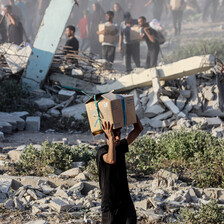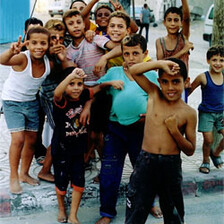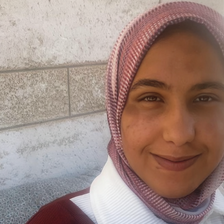The Electronic Intifada 29 April 2025

Our home in Gaza before the genocide, and our home in January 2025.
I was born in the year 2000 during the second intifada.
One of my earliest memories is of Israeli soldiers breaking into our house with a military dog. I was 4 years old, and I remember the dog sniffing around the rooms, a soldier shouting at us and then our being forced outside while they continued the search in the house for who knows what.
I was shaking from fear.
That story, like so many others of the occupation’s violence, was later confirmed by my parents.
Our home was among the few scattered near the Israeli settlement of Netzarim, which was built in 1972 in central Gaza. The mostly quiet area was not densely populated, yet it was heavily controlled by the Israeli occupation forces. The closer you lived to the settlement, the more your life was restricted.
The Israeli army operated freely there, but my family could not. We couldn’t leave the house or receive guests without the Israeli forces knowing. It seemed as if the Israeli occupation knew everything about our lives, including who came into our home and who left it. Visitors were treated as potential threats. Even walking outside at night during the second intifada could be dangerous.
I understood at a young age that Israeli soldiers preferred high places and that they did not want us to have access to such venues. The soldiers used the elevated spaces for surveillance and targeting, a better vantage point to watch us and to kill.
This was not a memory that needed more details or confirmation from my parents. It was something I learned in my youngest years living under the constant threat of violence.
So when my parents decided to add two more floors to our home years later, I remember feeling dread. Our house was already crowded – it was myself, my five brothers and one sister and my parents – and my parents wanted to give us more room. I couldn’t shake the fear that we might never get to enjoy those upper floors.
Operation Cast Lead
In August 2005, the Netzarim settlement was dismantled. I was too young then to remember how the occupation also destroyed all the buildings of the settlement as the settlers were evacuated.
I do know that even though the settlement was erased from the map, my fear remained – and with good reason.
My parents first built our home in 1998, but this home burned down in 2008 during the Israeli war on the Gaza Strip. Israeli forces temporarily reoccupied the Netzarim settlement, and even though firefighters tried to reach the area to put out the fire at our house, they were not allowed.
We had already evacuated by then and returned to a home that was burned from the inside out. All the contents of our house had been incinerated. Even the beds and wardrobes were melted. We do not know exactly how the home caught on fire, but we believe it was hit by an artillery shell. Israel’s use of white phosphorus shells from December 2008 to January 2009 on Gaza has been widely reported. These shells caused many deadly and destructive fires at that time.
Our home was rebuilt and painted tan with red trim in Italian paint. In Gaza, Italian paint is considered the finest quality paint, so it was clear that my parents took care in rebuilding and maintaining their dream home. Above the entryway, they had a saying painted, Hadha min fadl rubi, meaning, This is from the grace of God.
My grandmother lived with us, and generations came and went through our home’s doors. We were surrounded by olive trees and peach trees. Under occupation, though, your home does not always feel like your home. I remember telling my mother not to buy expensive things, as I believed that our home would not survive another war.
When Israel again attacked Gaza in 2014, we were forced to evacuate. At the very least, I understood by then that home is not always a permanent shelter and that evacuation could be required at any moment.
Our home survived that war, but in 2021, when my parents planned to add the floors to our home, I remembered my lesson from childhood about Israeli soldiers seeking high ground and knew I had something to worry about. The higher our house stood, the more it could become a target.
Our last evacuation
In 2023, Israel launched a genocide against the people of Gaza.
On 7 October, my family moved quickly and evacuated our home for a short while, packing only the essentials and valuables: birth certificates, IDs, some gold, a bit of money. We returned the next day only to evacuate again on 13 October, when the occupation ordered everyone to go south.
Looking at the evacuation map and seeing the extent of the areas marked “red” by the Israeli military, I understood that this war would not be like the last ones.
We went to my grandmother’s home in Nuseirat camp and stayed until 29 October when we returned home yet again, knowing that it would not be for long. Our neighbor’s home about 50 meters away was bombed, and we took that as a warning. We stayed for 30 minutes and then quickly left again.
In the months that followed, my family remained hopeful. They believed that even if Israeli forces invaded, our house would survive. I was not so optimistic. I foresaw tanks, invasion, destruction.
By March 2024, Israel had firmly established the Netzarim “corridor,” named after the former settlement. The occupation had built a road through Gaza, through our area, cutting the Strip in half.
To build this road, Israel destroyed homes and buildings, even bulldozing parts of a hospital to clear the way.
In the end, Israel’s buffer stretched 6 kilometers across Gaza, covering an area 4.5 kilometers wide.
Israeli soldiers had turned our area into a combat zone. We had seen the extent of the destruction in our area early on, in October 2023, but it was nothing compared to what was to come.
Sniper house
Throughout 2024, we didn’t have clear information about the state of our home – we only heard stories. But one story we heard over and over:
Friends and relatives who passed through the area during that year reported Israeli sniper fire coming from our home. Those two extra floors provided the occupation soldiers the high ground – I could hardly bear to think about how many lives were taken from our windows.
In January 2025, during the ceasefire that proved to be temporary, my father and brothers returned to our home. They described the scene as one of total destruction. The roads were torn up, and the trees had been uprooted. The destruction was so complete that they could hardly recognize our home, let alone the homes of our neighbors. The only trace that was still visible was the red-painted trim.
I didn’t choose this. I didn’t ask for my home to become a tool for the Israeli military to perpetuate violence.
Yes, I now hate my home. It was stolen from my family and used against my people.
Israel again withdrew from the Netzarim “corridor” in February 2025 only to again reoccupy the area in March.
Our home is gone, for the second time, and we do not know when we’ll be able to return to our area. I don’t know what it’s like to have a home that feels like home, and I hope one day I will have this.
Lubna Ahmad Abu Dahrouj is a writer in Gaza.


